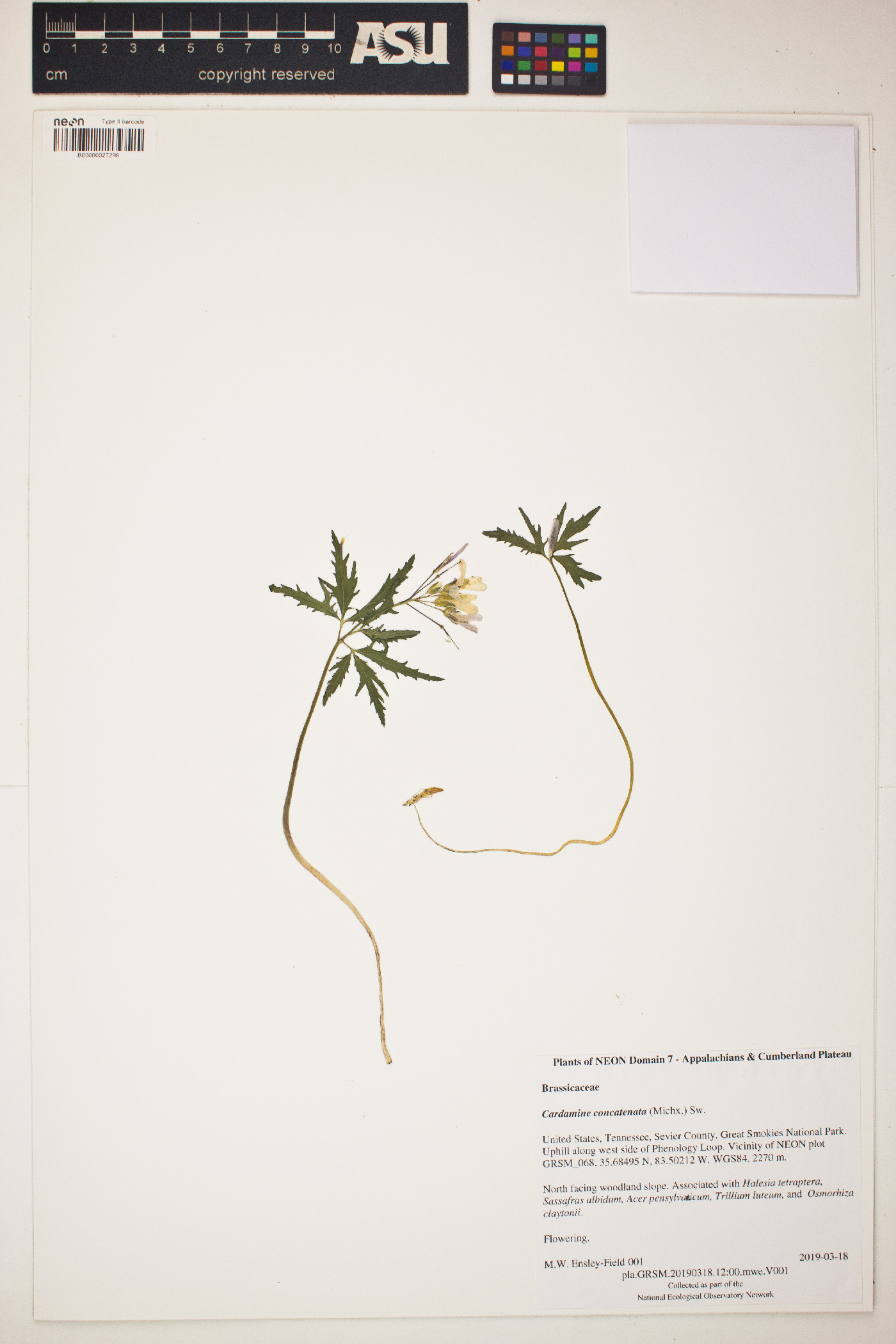Search
View the original page version
Cardamine concatenata
|
|
|
|
Family: Brassicaceae
cutleaf toothwort
[Cardamine laciniata F. Muell., moreDentaria concatenata Michx., Dentaria concatenata var. coalescens Fernald, Dentaria laciniata Muhl., Dentaria laciniata var. integra (O.E. Schulz) Fernald] |
Perennials; usually sparsely pubescent, sometimes glabrous. Rhizomes (tuberiform, fragile), moniliform, segments fusiform, 2-10(-20) mm diam. (fleshy). Stems erect, unbranched, (1-)2-4(-5.5) dm, glabrous or pubescent distally. Rhizomal leaves 3-foliolate, (7-) 10-20(-30) cm, leaflets sessile; petiole (4-)7-18(-25) cm; lateral leaflets similar to terminal, blade sometimes smaller; terminal leaflet blade oblong, lanceolate, oblanceolate, or linear, 2.5-6 cm, base cuneate, margins coarsely dentate to incised, laciniate, or 3-lobed (lobes usually toothed to incised, rarely entire, surfaces puberulent or not, trichomes 0.2-0.3 mm). Cauline leaves (2 or) 3, 3-foliolate (usually whorled or opposite, rarely alternate, similar in morphology to rhizomal leaves), petiolate, leaflets petiolulate or subsessile; petiole (1-)1.5-6(-7.5) cm, base not auriculate; lateral leaflets sessile, blade similar to terminal, sometimes smaller; terminal leaflet subsessile or petiolulate (to 3 cm), blade lanceolate, linear, or oblanceolate, (3-)4-10(-12) cm × (3-)5-20 (-25) mm, margins usually coarsely dentate to incised, rarely subentire (margins minutely puberulent). Racemes ebracteate. Fruiting pedicels ascending to divaricate, (6-) 10-27(-33) mm. Flowers: sepals oblong, (4-)5-8 × 2-4 mm, lateral pair slightly saccate basally; petals white to pale pink, oblanceolate, (8-)10-20 × (3-)4-7(-9) mm, (short-clawed, apex rounded); filaments: median pairs 8-12 mm, lateral pair 6-8 mm; anthers oblong-linear, 1.5-2.5 mm. Fruits linear-lanceolate, (2-)2.5-3.8(-4.8) cm × 1.5-3 mm; (valves glabrous or sparsely pubescent); ovules 10-14 per ovary; style (2-)5-9(-12) mm. Seeds brown, oblong, 1.6-3 × 1.8-2 mm. 2n = 128-256. Flowering Feb-May. Wooded bottoms and bluffs, rich woods, limestone cliffs and outcrops, rocky banks, mesic forests, moist areas with leaf litter, floodplain woods; 0-1000 m; Ont., Que.; Ala., Ark., Conn., Del., D.C., Fla., Ga., Ill., Ind., Iowa, Kans., Ky., La., Maine, Md., Mass., Mich., Minn., Miss., Mo., Nebr., N.H., N.J., N.Y., N.C., Ohio, Okla., Pa., S.C., Tenn., Tex., Vt., Va., W.Va., Wis. Perennial herb 20 - 40 cm tall Stem: upright, shortly hairy in upper parts. Flowers: in a loose, branched cluster, long-stalked, white to pink, 1 - 2 cm long. Sepals four, brownish green, to 3 mm long. Petals four, much longer than sepals. Stamens six. Fruit: a narrow pod, upright, ascending, 2 - 4 cm long, cylindrical. Rhizome: thick, constricted at intervals. The segments are 2 - 3 cm long. Basal leaves: tend to fall off before flowering. Stem leaves: usually three, whorled, above mid-stem, stalked, deeply lobed into three narrowly oblong to lance-shaped segments (lateral segments often divided, giving the appearance of a five-segmented leaf), lobes 6 cm long, 1 cm wide, often sharply toothed. Similar species: The similar Cardamine diphylla differs by having only two nearly opposite leaves and leaf segments that are broadly egg-shaped. Flowering: mid-March to late May Habitat and ecology: Locally abundant in mesic woods. Occurence in the Chicago region: native Notes: The tooth-like projections on the underground stems give this plant its name. Etymology: Cardamine comes from the Greek word kardamon, which refers to plants in the cress family. Concatenate means "linking together." Author: The Morton Arboretum Rhizome constricted at intervals, the segments 2-3 cm; stems 2-4 dm, shortly spreading-hairy above; basal and cauline lvs similar, the former usually absent at anthesis, the latter typically in a whorl of 3 above the middle of the stem, deeply 3-parted or 3-foliolate, the segments linear or lanceolate, subentire to laciniate-toothed, the lateral segments often, the terminal segment sometimes deeply bifid, the whole lf appearing 5-parted; sep 5-8 mm; pet pale lavender, 12-19 mm; frs 2-4 cm; 2n=128, 240, 256. Moist rich woods; Me. and s. Que. to Minn., s. to Fla., La., and Okla. Apr., May, a little earlier than nos. 1 [Cardamine diphylla (Michx.) A. W. Wood] and 5. (Dentaria laciniata) [Cardamine angustata O. E. Schulz] Some possible hybrids with no. 5 have been called Dentaria anomala Eames. Gleason, Henry A. & Cronquist, Arthur J. 1991. Manual of vascular plants of northeastern United States and adjacent Canada. lxxv + 910 pp. ©The New York Botanical Garden. All rights reserved. Used by permission. |


